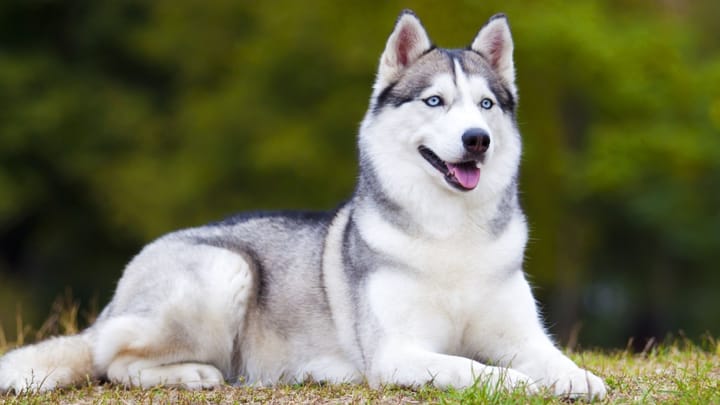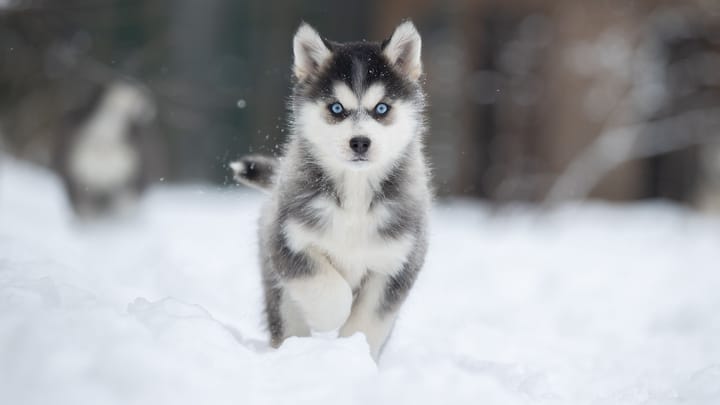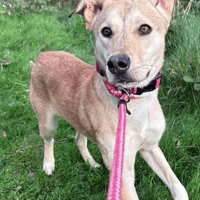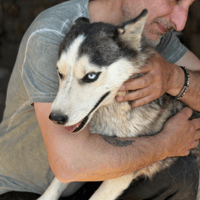Husky
Other names : Husky, Chukcha, Chuksha, Siberian Husky


Once seen in sled-dog competitions, Siberian Huskies are now more often kept as pets. These striking, gentle dogs suit those drawn to primitive breeds. Friendly with all, they make poor guard dogs. Highly independent and possessing a strong prey drive, Huskies require commitment and understanding. Choosing one as a companion should be a well-considered decision.
|
Life expectancy |
The Husky has a life expectancy of between 12 and 14 years |
|
Temperament |
|
|
Size |
Medium
|
|
Adult size |
Female
Between 20 and 22 in
Male
Between 21 and 24 in
|
|
Adult weight |
Female
Between 33 and 51 lb
Male
Between 44 and 62 lb
|
|
Coat colour
The Siberian Husky can be white, black, or all of the possible shades in between those two colours, except merle. |
White Black |
|
Type of coat
The hair is medium-long. The topcoat is straight and lies slightly flat without ever being hard to the touch. The undercoat is soft and dense. |
Long |
|
Eye colour
They can be blue, brown, china or parti-coloured. |
Blue
Brown
Odd-eyed
|
|
Purchase price |
The Husky costs between £520 and £600 |
The icy blue eyes which have earned this dog a certain claim to fame are not ‘obligatory’ and do not raise the value of a specimen. It is not the result of eye deterioration either, as some sources insist.
The blue-eyed Siberian Husky is simply sought-after by the breed’s enthusiasts in particular.
More details about the Husky
Husky: Origins and history
He has very ancient, nordic roots- Siberian, to be precise (hence the name). It is the indigenous Chukchie people who have created the breed, as they were in need of animals capable of hauling sleds, hunting, and keeping their children entertained. Legend has it that the Siberian Husky is born out of a union between a wolf and the moon. This is allegedly why the dog resembles a wolf, has a crescent-shaped tail, and howls when there’s a full moon… But the selective breeding of this dog has actually started in the United States, and was initiated by Eva ‘Short’ Seeley, who can be considered the ‘mother’ of this breed as well as the Alaskan Malamute. The American Kennel Club was the first to officially recognise the breed in 1930- the breed’s own first club saw the light of day eight years later. In the UK, it has been recognised as a breed by the Kennel Club in the 1970s.
Physical characteristics of the Husky
The Siberian Husky is a medium-sized dog, proportionately built with a slender and elegant appearance. The skull is slightly round; the muzzle, of medium size, tapers down towards the nose. The eyes are almond-shaped, slightly oblique. The ears are small, triangular, worn upright, set high and close to one another- they are slightly round at the tip, evenly covered in hair, even on the inside. The limbs are straight and muscular. The tail is sickle-shaped: it should not touch the back nor curl over to the side.
FCI classification of the Husky
-
Group 5 - Spitz and primitive types
-
Section 1 : Nordic Sledge Dogs
Husky: Characteristics
Husky: Behaviour
Training a Husky
The Siberian Husky clearly isn’t a master of obedience. He needs to be disciplined from a young age- this beautiful nordic dog needs to start being trained while still a pup.
His independent nature makes him question his master’s commands all the time. It is of utmost necessity that a relationship based on mutual respect and trust is established in order to obtain this primitive dog’s full cooperation.
It would be futile to want to turn him into a ‘circus dog’, since he is generally not keen on carrying a wide variety of tasks out. The very basics of dog training (heel, hailing, static position) will have to consolidate over and over again throughout his whole life- with Huskies nothing is ever completely mastered.
Husky: Lifestyle
Breed compatibility Husky
Husky: Purchase price
The price of a Siberian Husky varies depending on its origins and age. You have to count an average of £600 for dogs subscribed to the Kennel Club.
With regards to the monthly budget required to meet the needs of a dog of this size, you have to estimate an average of £40 per month.
Husky: Shedding
Heavy !
Moulting seasons are very significant and can last for several weeks. Aside from that, the dog does not experience much hair loss.
Husky: Grooming
This primitive dog’s abundant coat does require regular brushes. Bathing or grooming is not necessary unless the dog is very dirty.
A simple trimming of certain areas of the coat is authorised for show dogs.
Husky: Health
Life expectancy is estimated at 13 years.
The Siberian Husky is a primitive, very robust dog, since it has not been modified much by Man.
Contrary to popular belief, he does not suffer that much in the heat. In fact, during the summer, he sheds his undercoat. His coat generally adapts to various climates very well.
The Siberian Husky is a dog that can live in - 40° temperatures, which doesn’t necessarily means he prefers to!
If he does not get sufficient amounts of exercise, the Siberian Husky can indeed quickly become prone to obesity.
Do you want a Husky dog ?
Frequently asked questions
Can you leave a Husky alone?
A Siberian Husky should not be left alone. If you leave your Husky dog for too long, it will result in separation anxiety and destructive behaviour. Huskies are very social and need to be surrounded by humans or other dogs. You can leave your Husky for a few hours, but make sure it isn't any longer than 6 hours.
How many times a day should you walk a Husky?
Huskies are very active dogs and love nothing more than to go on long walks, hiking, or running. They could go on all day if they wanted to. Indeed, they are often used as sled dogs because of their desire to run long distances. Make sure you walk your Husky at least twice a day 30 to 45 minutes.
What kind of breed is a Husky?
The Siberian Husky is a Nordic and primitive dog breed. They have striking eyes, a beautiful coat colour and a unique personality. Actually, because the Husky has a lot of positive traits, this breed is often mixed with other breeds.














